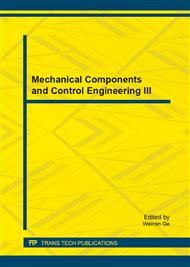p.803
p.808
p.812
p.818
p.822
p.826
p.830
p.836
p.840
Design of Digital Clock Based on SCM
Abstract:
The digital clock is the timing device by using of the digital circuit to implement the digital display for hours, minutes and seconds. Due to the development of the digital integrated circuit and the wide application of the quartz crystal oscillator, the accuracy of the digital clock is far more than the old clocks’. The control part of the design is SCM AT89C51, and the compiler environment is Keil. The software is developed with C language, and the simulation debugging is used Proteus. The digital clock is convenient to people’s production and life, and it expands the original time function of the clocks greatly. Development trend of electronic instrumentation, and has broad market prospects. The clock can be used in many fields, such as the timing automatic alarm, the automatic schedule bell, the time program automatic control, the regular radio, the automatic lights close, the oven timer switch, etc.
Info:
Periodical:
Pages:
822-825
Citation:
Online since:
October 2014
Authors:
Keywords:
Price:
Сopyright:
© 2014 Trans Tech Publications Ltd. All Rights Reserved
Share:
Citation:


